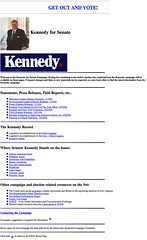For most of the last 15 years I have had some sort of online presence or other. Working at the intersection of politics and technology means I have a closet full of campaign yard signs and a GoDaddy account with a collection of domain names, most important among them being my own, casey.com. Over the years, both the technology and the content of my online world have evolved along with the tools and my own interests. Once such change came this week, when I moved my blogs from TypePad to Posterous (on which this will be one of my first full postings). Over the last couple of years, Facebook and Twitter have largely replaced my personal blog as my primary online outlet and I could no longer justify paying $15 a month for a blogging when very good free alternatives were available. The process of moving old blogs posts from one system to another is a bit like moving from one home to another. The tasks gets can get sidetracked as you re-read old posts, just as you might get off task while moving by going through an old box of photos. And it was that sort of reflection, combined with a New Year’s determination to write more, that inspired this blog posting. Probably of interest to few but myself, but it’s always been the case that I am my own main target audience online.
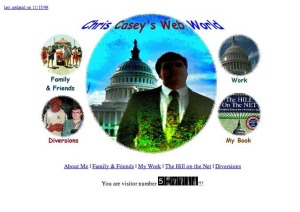
My own online presence was established sometime in 1997. The earliest capture of casey.com from The Internet Archive is dated December 27, 1996 and shows a welcome screen from CAIS, the Capitol Area Internet Service, my first ISP. Sadly, the whole year of 1997 is a black whole, and it’s not until December 1, 1998. The oldest ‘What’s New‘ entry from January 28, 1998 says the whole site is new. I’m pretty sure it’s my oldest site, I don’t remember another, but aging is a terrible thing and my memory often fails me. If The Internet Archive says this is my oldest web site, who am I to argue? Looking back, I’m still pleased with this simple page, and my current web site is not dramatically different. I’m sure I was proud of my image mapping (alternate text links provided of course!), and my gag on the then popular feature of an odometer style hit-counter still makes me smile (it’s an animated gif with endlessly spinning numbers). My “Web World” is divided into simple buckets; Family & Friends, Work, Diversions, and My Book. It’s telling that the Capitol Dome appears three time, Admiral Ackbar once, and that I once wore a suit and tie. I still wear the shirt from that photo with Ackbar, but I rarely wear a suit anymore.
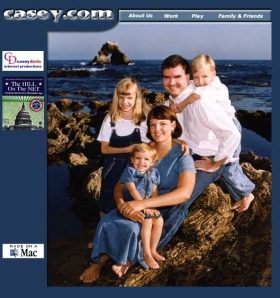
Sometime in June 2000, I launched a re-designed site. The content was essentially the same, but a new large family photo dominates the page. This was shortly after I left the U.S. Senate after eight years of working there, and a subtle plug for my new Internet Consulting firm can be seen along with my book plug. And gone are those old school image maps, I was using Adobe ImageReady at this point, and all about the slices and mouseovers!
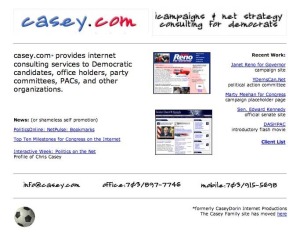
The new look only lasted about a year. My business partner left to go to law school, and so CaseyDorin Internet Productions became simple casey.com, and what had previously been my personal web site, was now my business site, launching in August of 2001. It started as a clean and simple plain HTML site, but at some point around this time I was introduced to Movable Type web publishing software. A friend installed MT on my server and I began using it for my client sites. The animated soccer ball led to team photos of my son and daughter’s soccer teams that I had sponsored. It was already fun watching my youngsters and their teammates play soccer. It was cooler still watching them do it in jersey’s with my casey.com logo on the front! My website’s focus had changed to be primarily for my business, but my personal life was still closely connected to it. For four years I was my own boss and only employee, and casey.com showcased a wide variety of Democratic clients with whom I was fortunate to work with.
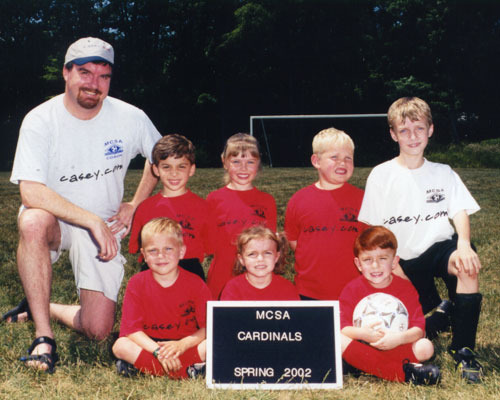
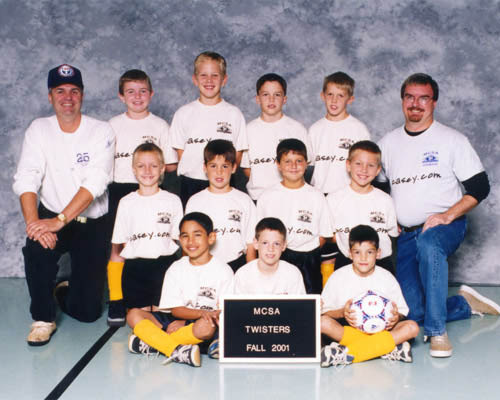
2004 was the year of the blog, and I jumped on the bandwagon big time. Just look over in the right column of this current version of my blog, and you’ll see how my output has never been higher than it was in 2004 and 2005. My interest in technology, writing, an online exhibitionism converged, heated up by the Presidential election year. I spent the last three months of the campaign working full-time at the DNC. And while it was devastating for Kerry to lose and give a second term to Bush, it would also mean the end of casey.com as a business. For some time I had been encouraging clients to use NGP Software’s contribution and campaign database tools as the back end for the web sites that I built for them. Now NGP offered me a job, building a team to continue what I was already doing and I jumped at the opportunity to work there. It took me until the following year to once again makeover my website, returning it to it’s original ego-centric purpose in March of 2005.
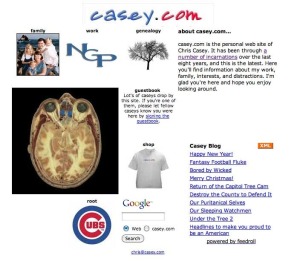
This new site reflected the growth of my online world. No longer just a destination where my personal content could all be found in one place, it was instead a portal that combined my own content, especially blogs posts and such, but contained a variety of links to my activities elsewhere on the web, such as my auctions on eBay, photos on Flickr, swag on CafePress, and a number of randomized links to the things that interest me such as The Cubs, Apple Computer, and my own family tree. This site also included a prominent link to the Internet Archive for casey.com to share it’s evolution with visitors.
Everything changed in 2007. With my blogging output already in decline, new online outlets became available to the made it easier to find an audience of my friends, and to share my thoughts online in a rapid-fire manner contrary to the more thoughtful type of writing I typically sought to create for my blog.
My first post on Facebook was on February 9, 2007. Here’s what I said…
Chris Casey Wednesday, pipes freeze, burst, water in basement
Thursday, powerbook dies, hard drive failure, everything lost
Thursday night, wife succumbs to the flu, major upchucking…
TGIF!
February 9, 2007 at 10:19 am
I joined Twitter in May of 2007, but after a single tweet I set it aside and forgot about it. I really just didn’t ‘get’ twitter. It wasn’t until July of 2008 that I became an active tweeter.
Here’s my second tweet from three months later …
But after that slow start, my tweeting picked up, especially at the next year’s Netroots Nation conference in in Austin. And I know exactly why. It was in Austin in July of 2008 that I stood in a long line and bought the 2nd generation iPhone, a gadget I had waited a very long time for. Mobile access to Facebook and Twitter allowed me to embrace each wholeheartedly, and I now reached my online world in tweets and status updates rather than through blog posts. My people would see what I wrote, and I prolifically wrote more while saying less. According to TweetStats, I now average 3.3 tweets a day.
It’s interesting that I announced my location in my first two tweets (also my only two tweets for all of 2007), as it foretells the later arrival of location aware services that the currently all the rage thanks to our gps-equipped smart phones. At the close of 2009, I began exploring location services on my iPhone. I was familiar with Foursquare (first checkin on 12/29/09) and Loopt, but knowing that there was likely other options out there, I iput the question out there on Facebook, and I learned about Gowalla.
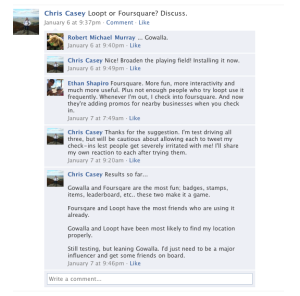
My first check-in on Gowalla was when I created my Neighborhood ABC Store on January 8, 2010. For a time I used it equally with Foursquare, but I enjoyed the interface and interactions much better on Gowalla and now effectively use it exclusively for ‘checking-in’. I’m exactly the sort of OCD geek that finds it appealing to make sure the world knows I’ve been to the neighborhood McDonalds, have earned my Voyager pin and plan to one day complete that Sea to Shining Sea trip as well!
And then here I’m am, writing about this all, in my good old (new) blog here on Posterous. Once I publish this post, it will be tweeted and added to my Facebook wall. I guess this post will require a ‘Part II’, because I haven’t even mentioned Ancestry.com, Find-A-Grave, PayPal, eBay, Flickr, TwitPic, etc. etc….
But I’m ready to move ahead with Part I here, so just stay tuned…
Like this:
Like Loading...
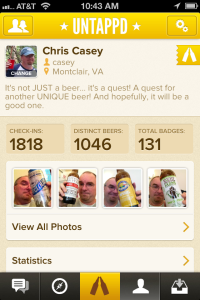 I will be the first to admit that I frequently demonstrate symptoms of OCD. It’s not crippling, or anything weird, but I frequently like to count and categorize things. In some cases it can be useful, for example it has added to my success and enjoyment of constructing my family tree. Other times, it serves no purpose at all other than to satisfy my own curiousity. That was the case when I spent a day counting and categorizing my t-shirts, just so I could understand the big picture of my t-shirt collection. Or when I took a photo of myself (almost) everyday for a year in order to make a short movie..
I will be the first to admit that I frequently demonstrate symptoms of OCD. It’s not crippling, or anything weird, but I frequently like to count and categorize things. In some cases it can be useful, for example it has added to my success and enjoyment of constructing my family tree. Other times, it serves no purpose at all other than to satisfy my own curiousity. That was the case when I spent a day counting and categorizing my t-shirts, just so I could understand the big picture of my t-shirt collection. Or when I took a photo of myself (almost) everyday for a year in order to make a short movie..







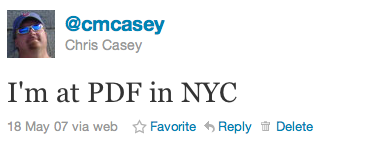
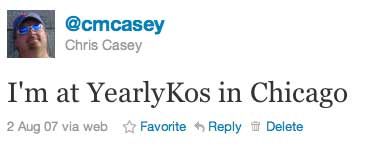

 Dear Apple,
Dear Apple,
